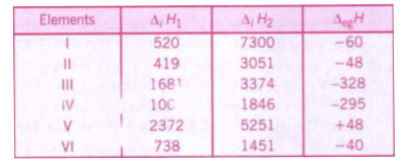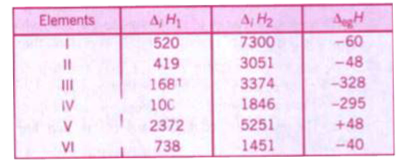Complete Solutions to NCERT TEXT-BOOK. EXERCISE (With Hints and Solutions) of chapter CLASSIFICATION OF ELEMENTS AND PERIODICITY IN PROPERTIES of Class 11 book with complete answers and questions
| Class 11 | CHEMISTRY |
| Chapter | CLASSIFICATION OF ELEMENTS AND PERIODICITY IN PROPERTIES |
| NOOTAN | NCERT TEXT-BOOK. EXERCISE (With Hints and Solutions) |
| Number Of Questions | 63 |
| Academic Year | 2023-24 |
What is the basic theme of organisation in the periodic table?
View SolutionWhich important property did Mendeleev use to classify the elements in his periodic table and did he stick to that?
View SolutionWhat is the basic difference in approach between the Mendeleev’s Periodic Law and the Modern Periodic Law?
View SolutionOn the basis of quantum numbers, justify that the sixth period of the periodic table should have 32 elements.
View SolutionIn terms of period and group where would you locate the element with Z =114?
View SolutionAtomic number of element present in the third period and seventeenth group of periodic table
View SolutionWhich element do you think would have been named by
Lawrence Berkley Laboratory ?
View SolutionWhich element do you think would have been named by
Seaborg's group?
View SolutionWhy do elements in the same group have similar physical and chemical properties?
View SolutionWhat does atomic radius and ionic radius really mean to you?
View SolutionHow do atomic radii vary in a period and in a group? How do you explain the variation?
View SolutionWhat do you understand by isoelectronic species? Name a species that will be isoelectronic with each of the following atoms or ions:
`F^(-)`
View SolutionWhat do you understand by isoelectronic species? Name a species that will be isoelectronic with each of the following atoms or ions:
`Ar`
View SolutionWhat do you understand by isoelectronic species? Name a species that will be isoelectronic with each of the following atoms or ions.
(i) `F^(-)` (ii) Ar (iii) `Mg^(2+)` (iv) `Rb^(+)`
View SolutionWhat do you understand by isoelectronic species? Name a species that will be isoelectronic with each of the following atoms or ions.
(i) `F^(-)` (ii) Ar (iii) `Mg^(2+)` (iv) `Rb^(+)`
View SolutionConsider the following species:
`N^(3-),O^(2-),F^(-),Na^(+),Mg^(2+)` and `Al^(3+)`
What is common in them?
View SolutionWhat is common between given cations and anions,`O^(2-)F^(-),Na^(+),Mg^(2+),AI^(3+)`?
View SolutionExplain why cation are smaller and anions larger in radii than their parent atoms?
View SolutionWhat is the significance of the terms — ‘isolated gaseous atom’ and ‘ground state’ while defining the ionization enthalpy and electron gain enthalpy?
Hint : Requirements for comparison purposes.
View SolutionEnergy of an electron in the ground state of the hydrogen atom is `-2.18xx10(-18)J`. Calculate the ionization enthalpy of atomic hydrogen in terms of J `"mol"^(-1)`.
Hint: Apply the idea of mole concept to derive the answer.
View SolutionAmong the second period elements the actual ionization enthalpies are in the order `Li lt B lt Be lt C lt O lt N lt F lt Ne`.
Explain why
(i) Be has higher ∆i H than B
(ii) O has lower ∆i H than N and F?
View SolutionAmong the second period elements the actual ionization enthalpies are in the order `Li lt B lt Be lt C lt O lt N lt F lt Ne`.
Explain why
(i) Be has higher ∆i H than B
(ii) O has lower ∆i H than N and F?
View SolutionHow would you explain the fact that the first ionsiation enthalpy of sodium is lower than that of magnesium but its second ionisation enthalpy is higher than that of magnesium?
View SolutionWhat are the various factors due to which the ionization enthalpy of the main group elements tends to decrease down a group?
View SolutionThe first ionisation enthalpy values (in kJ `mol^(-1)`) of group 13 elements are

How would you explain this deviation from the general , trend?
View SolutionWhich of the following pairs of elements would have a more negative electron gain enthalpy?
O or F
View SolutionWhich of the following pairs of elements would have a more negative electron gain enthalpy?
For Cl
View SolutionWould you expect the second electron gain enthalpy of O as positive , more negative or less negative than the first? Justify your answer.
View SolutionWhat is the basic difference between the terms electron gain enthalpy and electronegativity?
View SolutionHow would yon react to the statement that the electronegativity of N on Pauling scale is 3.0 in all the nitrogen compounds?
View SolutionDescribe the theory associated with the radius of an atom as it
gains an electron
View SolutionDescribe the theory associated with the radius of an atom as it
loses an electron
View SolutionWould you expect the first ionization enthalpies for two isotopes of the same element to be the same or different? Justify your answer.
View SolutionWhat are the major differences between metals and non-metals?
View SolutionUse the periodic table to answer the following questions :
Identify an element with five electrons in the outer subshell.
View SolutionUse the periodic table to answer the following questions :
Identify an element that would tend to lose two electrons.
View SolutionUse the periodic table to answer the following questions :
Identify an element that would tend to gain two electrons.
View SolutionUse the periodic table to answer the following questions :
Identify the groups having metal, non-metal, liquid as well as gas at the room temperature.
View SolutionThe increasing order of reactivity among group 1 elements is `Li lt Na lt K lt Rb lt Cs` whereas that among group 17 elements is `F gt CI gt Br gt I`. Explain.
View SolutionWrite the general outer electronic configuration of s-, p-, d- and f- block elements.
View SolutionAssign the position of the element having outer electronic configuration `ns^(2) np^(4)` for n = 3, in the periodic table.
View SolutionAssign the position of the element having outer electronic configuration `(n - 1) d^(2)ns^(2)` for n = 4 in the periodic table.
View SolutionAssign the position of the element having outer electronic configuration `(n - 2) f^(7) (n - 1) d^(1) ns` for n = 6, in the periodic table.
View SolutionThe first (`Delta_(i), H_(1)`) and the second (`Delta, H_(2)`) ionisation enthalpies (in kJ mo`l^(- 1)` ) and the `(Delta_(eg)H`) electron gain enthalpy (in kJ mo`l^(-1)` ) of a few elements are given below :

Which of the above elements is likely to be :
the least reactive element?
View SolutionThe first (`Delta_(i), H_(1)`) and the second (`Delta, H_(2)`) ionisation enthalpies (in kJ mo`l^(- 1)` ) and the `(Delta_(eg)H`) electron gain enthalpy (in kJ mo`l^(-1)` ) of a few elements are given below :

Which of the above elements is likely to be :
the least reactive element?
View SolutionThe first (`Delta_(i), H_(1)`) and the second (`Delta, H_(2)`) ionisation enthalpies (in kJ mo`l^(- 1)` ) and the `(Delta_(eg)H`) electron gain enthalpy (in kJ mo`l^(-1)` ) of a few elements are given below :

Which of the above elements is likely to be :
the least reactive element?
View SolutionThe first (`Delta_(i), H_(1)`) and the second (`Delta, H_(2)`) ionisation enthalpies (in kJ mo`l^(- 1)` ) and the `(Delta_(eg)H`) electron gain enthalpy (in kJ mo`l^(-1)` ) of a few elements are given below :

Which of the above elements is likely to be :
the least reactive element?
View SolutionCalculate the work done when 1.0 mole water at 373K vaporizes against an atmospheric pressure of 1.0 atmosphere. Assume ideal gas behaviour.
View SolutionThe first (`Delta_(i), H_(1)`) and the second (`Delta, H_(2)`) ionisation enthalpies (in kJ mo`l^(- 1)` ) and the `(Delta_(eg)H`) electron gain enthalpy (in kJ mo`l^(-1)` ) of a few elements are given below :

Which of the above elements is likely to be :
a reactive metal
View SolutionPredict the formulae of the stable binary compounds that would be formed by the combination of the following pairs of elements.
Lithium and oxygen
View SolutionPredict the formulae of the stable binary compounds that would be formed by the combination of the following pairs of elements.
Magnesium and nitrogen
View SolutionPredict the formulae of the stable binary compounds that would be formed by the combination of the following pairs of elements.
Aluminium and iodine
View SolutionPredict the formulae of the stable binary compounds that would be formed by the combination of the following pairs of elements.
Silicon and oxygen
View SolutionPredict the formulae of the stable binary compounds that would be formed by the combination of the following pairs of elements.
Phosphorus and fluorine
View SolutionPredict the formulae of the stable binary compounds that would be formed by the combination of the following pairs of elements.
Element 71 and fluorine.
View SolutionIn the modern periodic table, the period indicates the value of :
View SolutionWhich of the following statements related to the modern periodic table is incorrect?
View SolutionAnything that influences the valence electrons will affect the chemistry of the element. Which one of the following factors does not affect the valence shell?
View SolutionThe size of isoelectronic species `- F^(-)`, Ne and `Na^(+)` is affected by
View SolutionWhich one of the following statements is incorrect in relation to ionization enthalpy?
View SolutionConsidering the elements B, Al, Mg, and K, the correct order of their metallic character is :
View SolutionConsidering the elements B, C, N, F, and Si, the correct order of their non-metallic character is :
View SolutionConsidering the elements F, Cl, O and N, the correct order of their chemical reactivity in terms of oxidizing property is :
View Solution
NCERT TEXT-BOOK. EXERCISE (With Hints and Solutions) questions and complete solutions for chapter CLASSIFICATION OF ELEMENTS AND PERIODICITY IN PROPERTIES of NAGEEN CHEMISTRY (ENGLISH) of Class 11
All Exercises from NOOTAN Class 11 CHEMISTRY CLASSIFICATION OF ELEMENTS AND PERIODICITY IN PROPERTIES
- ASSERTION-REASON TPE QUESTIONS
- ESSAY (LONG ANSWER) TYPE QUESTIONS
- EXAMPLE
- FILL IN THE BLANKS. TYPE QUESTIONS
- NCERT TEXT-BOOK. EXERCISE (With Hints and Solutions)
- OBJECTIVE (MULTIPLE CHOICE) TYPE QUESTIONS
- REVIEW EXERCISES
- SHORT ANSWER TYPE QUESTIONS
- TRUE OR FALSE TYPE QUESTIONS
- VERY SHORT ANSWER TYPE QUESTIONS